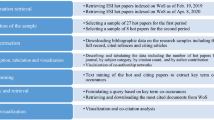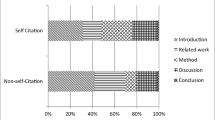Abstract
Ecologists writing research articles frequently cite their own papers. Self-citations are frequent in science, but the reasons behind abnormally high rates of self-citations are questionable. My goals were to assess the prevalence of author self-citations and to identify the combination of attributes that best predict high levels of self-citations in ecology articles. I searched 643 articles from 9 different ecology journals of various impact factors for synchronous (i.e., within reference lists) and diachronous (i.e., following publication) self-citations, using the Web of Science online database. I assessed the effect of the number of authors, pages, and references/citations, the proportion of diachronous/synchronous self-citations, and the impact factor, on the proportion of synchronous and diachronous self-citations separately. I compared various candidate models made of these covariates using Akaike’s Information Criterion. On average, ecologists made 6.0 synchronous self-citations (12.8% of references), and 2.5 diachronous self-citations (25.5% of citations received 2.8 to 4.5 years after publication) per article. The best predictor of the proportion of synchronous self-citations was the number of authors. My study is the first to report recidivism in the inclusion of self-citations by researchers, i.e., the proportion of diachronous self-citations was best explained by the proportion of synchronous self-citations. The proportion of self-citations also increased with the number of pages and the impact factor of ecology journals, and decreased with the number of references/citations. Although a lot of variance remained unexplained, my study successfully showed regularities in the propensity of ecologists to include self-citations in their research articles.
Similar content being viewed by others
Notes
E.g., the impact factor of a journal in 2006 is the number of times articles published by the journal in 2004–2005 were cited in indexed journals in 2006, divided by the number of articles published by the journal in 2004–2005.
References
Aksnes, D. W. (2003). A macro study of self-citations. Scientometrics, 56, 235–246.
Amin, M., & Mabe, M. (2000). Impact factors: Use and abuse. Perspectives in Publishing, 1, 1–6.
Burnham, K. P., & Anderson, D. R. (2002). Model selection and inference: A practical information–theoretic approach. New York: Springer-Verlag.
Costas, R., van Leeuwen, T. N., & Bordons, M. (2010). Self-citations at the meso and individual levels: Effects of different calculation methods. Scientometrics, 82, 517–537.
Falagas, M. E., & Alexiou, V. G. (2008). The top-ten in journal impact factor manipulation. Archivum Immunologiae et therapiae Experimentalis, 56, 223–226.
Fowler, J. H., & Aksnes, D. W. (2007). Does self-citation pay? Scientometrics, 72, 427–437.
Garfield, E. (2006). The history and meaning of the journal impact factor. The Journal of the American Medical Association, 295, 90–93.
Garfield, E., & Sher, I. H. (1963). New factors in the evaluation of scientific literature through citation indexing. American Documentation, 18, 195–201.
Garfield, E., & Welljams-Dorof, A. (1992). Citation data: Their use as quantitative indicators for science and technology evaluation and policy-making. Science and Public Policy, 19, 321–327.
Glänzel, W., Debackere, K., Thijs, B., & Schubert, A. (2006). A concise review on the role of author self-citations in information science, bibliometrics and science policy. Scientometrics, 67, 263–277.
Glänzel, W., Thijs, B., & Schlemmer, B. (2004). A bibliometric approach to the role of author self-citations in scientific communication. Scientometrics, 59, 63–77.
Hirsch, J. E. (2005). An index to quantify an individual’s scientific research output. Proceedings of the National Academy of Sciences, 102, 16569–16572.
Hutson, S. R. (2006). Self-citations in Archaeology: Age, gender, prestige, and the self. Journal of Archaeological Method and Theory, 13, 1–18.
Hyland, K. (2001). Humble servants of the discipline? Self-mention in research articles. English for Specific Purposes, 20, 207–226.
Hyland, K. (2003). Self-citation and self-reference: Credibility and promotion in academic publication. Journal of the American Society for Information Science and Technology, 54, 251–259.
Katz, J. S., & Martin, B. R. (1997). What is research collaboration? Research Policy, 26, 1–18.
Krauss, J. (2007). Journal self-citation rates in ecological sciences. Scientometrics, 73, 79–89.
Lawani, S. M. (1982). On the heterogeneity and classification of author self-citations. Journal of American Society for Information Science, 33, 281–284.
Leimu, R., & Koricheva, J. (2005). Does scientific collaboration increase the impact of ecological articles. BioScience, 55, 438–443.
Macdonald, S., & Kam, J. (2011). The skewed few: People and papers of quality in management studies. Organization, 18, 467–475.
Pichappan, P., & Sarasvady, S. (2002). The other side of the coin: The intricacies of author self-citations. Scientometrics, 54, 285–290.
Rousseau, R. (1999). Temporal differences in self-citation rates of scientific journals. Scientometrics, 44, 521–531.
Snyder, H., & Bonzi, S. (1998). Patterns of self-citation across disciplines. Journal of Information Sciences, 24, 431–435.
Thijs, B., & Glänzel, W. (2006). The influence of author self-citations on bibliometric meso-indicators. The case of european universities. Scientometrics, 66, 71–80.
White, H. D. (2001). Authors as citers over time. Journal of the American Society for Information Science and Technology, 52, 87–108.
Zhivotovsky, L. A., & Krutovsky, K. V. (2008). Self-citation can inflate h-index. Scientometrics, 77, 373–375.
Author information
Authors and Affiliations
Corresponding author
Rights and permissions
About this article
Cite this article
Leblond, M. Author self-citations in the field of ecology. Scientometrics 91, 943–953 (2012). https://doi.org/10.1007/s11192-011-0565-9
Received:
Published:
Issue Date:
DOI: https://doi.org/10.1007/s11192-011-0565-9




